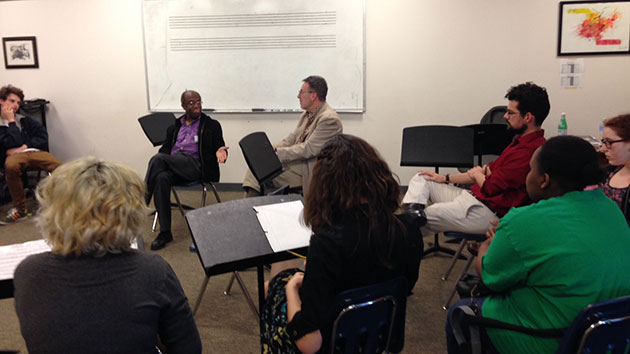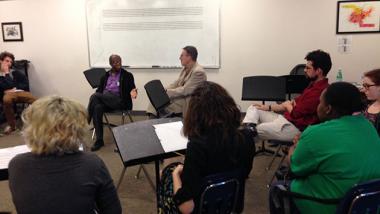
Oliver Palmer
Most, of the Oakland East Bay Symphony concerts I have attended oriented themselves around a central theme or idea. Pieces in similar styles or with comparable backgrounds would be joined together, and it would feel to the audience as if everything just fit perfectly. I cannot, however, identify the slightest theme or idea which Gershwin’s Piano Concerto in F major shares with Shostakovich’s Symphony No. 8 in C Minor. Despite having been written within 20 years of each other, the upbeat, dynamic concerto filled to the brim with character and the desperate, lamenting symphony which Shostakovich would come to regard as “his requiem” could not possibly be any more different.
However, this drastic juxtaposition didn’t at all hurt the concert. As complete opposites, the two pieces serve to give depth to the extremes which the other occupies. Each piece acts as a sort of musical foil to the other, and it helps to bring out the subtleties and nuance which might have been missed if the two were heard separately.
This was Gershwin’s first ever traditional piano concerto, completed in a little over a year with only the help of “four or five books on musical structure.” With OEBS and soloist Richard Glazier bringing the concerto to life with a dramatic and captivating performance however, it didn’t sound like anything like a first attempt. Across three movements, the Gershwin exudes character, playfulness, intensity, and lighthearted solemnity which all capture a sort of melancholic hustle and bustle straight out of the 1920s.
The first movement is upbeat from the beginning, with an almost hectic joviality as lines are passed amongst the sections with dramatic unpredictability. It isn’t without drawn-out exposed piano solos as well, but the second movement contains most of the more intimate sections. The second movement begins with a slow, muted trumpet solo over a full-bodied clarinet trio. The crispness of the tantalizing, muted trumpet blended incredibly well with the pure tones of the clarinets. This sweet, melancholic section is without a doubt my favorite part of the entire concerto. Eventually the music picks back up as it transitions into the final movement, which brings back much of the energy from the first movement. The entire piece is incredibly exciting and captivating, and the orchestra’s performance perfectly captured the feel and atmosphere of Gershwin’s time.
Departing tremendously from the style of the Gershwin, Shostakovich’s vast Symphony No. 8 filled out the second half of the concert (which is an understatement.) Shostakovich began writing his Eighth Symphony in 1943, while World War II was taking its toll on his home country of Russia. The symphony was written, in Shostakovich’s words, as “an attempt to express the emotional experience of the people, to reflect the terrible tragedy of the war.” Russia’s government subtitled it the Stalingrad Symphony, memorializing the millions of Russian casualties resulting from the Battle of Stalingrad, with tens of thousands of those being civilians.
Shostakovich did everything possible to convey “the experience of the people” through his bleakly beautiful, hour-long symphony. His first movement spans half the piece. It is dramatic and dissonant, with spontaneous, crying motifs characterized by anguish and despair. It is substantial in length and conveyed feeling.
The second movement and the third are both march-like scherzos. They convey a militaristic feel, and both are teeming with imagery of battles and combat. The Largo comes next, and it brings a starkly different intensity. It is slow and ethereal: It captures a sense of bitterness and grief, and it leaves the audience to experience the dragging, nearly stagnant despair and pain felt by those Shostakovich sought to memorialize.
The final movement, a second Allegretto, is pastoral and in C Major. However, it is not a resolution in the sense that there is any triumph or victory to be found. The piece ends with sustained, ethereal harmonics over the delicate, major melody, which serves to remind the audience that resolution cannot override the “people’s” deep grief and suffering.
[The final movement] is not a resolution in the sense that there is any triumph or victory to be found. The piece ends with sustained, ethereal harmonics over the delicate, major melody, which serves to remind the audience that resolution cannot override the “people’s” deep grief and suffering. – Oliver PalmerOakland East Bay Symphony’s performance of Shostakovich’s Symphony No. 8 left me feeling a wordless despair through the rest of my night.
Oakland East Bay Symphony’s Gershwin and Shostakovich concert was outstanding. With an incredible orchestra, conductor, and solo pianist, they were able to bring together two remarkably different pieces through impeccable musicianship and great regard for the styles and composers’ intents. As I have been in the past, I was thoroughly amazed.
Barbara Joy
Michael Morgan, the conductor of the Oakland East Bay Symphony, has aspired to perform Shostakovich’s Eighth Symphony for years. And January 23, at the Paramount Theater his aspiration became reality.
The pairing of the two pieces was complimentary. The contrast of the sad and slow movement of the Gershwin Piano Concerto and the fast insanity of Shostakovich's Eighth was executed perfectly. These performances made me feel energetic and melancholy because of their two different styles.
Morgan was not showing the audience much during the Gershwin because it was mostly led by the piano soloist. But that did not stop him from being expressive during the Shostakovich performance. Not only did Morgan show the audience how the music was supposes to feel, but he directed the audience’s attention to the moving line, soloist, or melody. Throughout the Gershwin Concerto, the piano maintained the melody most of the way, and if not the piano, the strings would carry lyrical, long phrases.
Shostakovich's melodies moved throughout the wind and brass section with an occasional string melody. Keeping the melody between the winds and brass is smart for a piece like Shostakovich’s Eighth because it is a series of upbeat, fanfare pieces that require a lot of winds to stay in character, unlike the Gershwin, which is based on phrasing and lyricism. The orchestra showed their skill by performing these two contrasting pieces on such a high skill level.
Tea Sherman Kennedy
Following the intermission (between Gershwin and Shostakovich) and more specifically the third movement, I found my ears attentive and my eyes glued to the stage. I notice the bass section first, of course, before my eyes fell upon a flurry of cellos, violins, violas, winds, brass, and various percussive instruments. As the show moved on I was more exited and less tired that I had previously, for the hour was late. When attending the concert I experienced both feelings of beauty and sublimity, through gracefully executions and smooth transitions paralleled with intermittent sounds I was enthralled.
Taylor Moses
The Piano Concerto in F Major by George Gershwin was definitely my favorite part of the concert, because the music was uplifting and lively. The soloist was energetic and had a sort of jazziness to him that made the sections that featured the piano almost danceable. I was so down to boogie by the time the intermission came around I could barely stay in my seat.
However, the piece became more conflicted and complex around the middle. I thought this added depth and character and made it more than a stereotypical dance piece. I particularly enjoyed the sections that featured the brass and percussion. These sections gave a contrast to airy dance-like nature of the woodwinds and the strings.
After intermission, the audience was quickly educated on the next piece, Dmitri Shostakovich‘s Symphony No. 8 in C Minor, Op. 65. This was well played, and sounded amazing. Unfortunately, the piece was not at all fulfilling; I found myself feeling quite grim after the nearly hour-and-a-half-long piece.
Shostakovich wrote this symphony in the midst of World War Two in Russia, where if the war was lost, Russia would be ruled by Hitler. It consisted of five moments, each of them grimmer than the one preceding it. The only relief from the never-ending grimness was the gong. At particularly tense moments, the drum section leader would ring the gong loudly. The sound resonated through the crowd, bringing joy to the joyless music, product of the joyless time it was written in.
Fatir Muhammad
The music started and the 50 or more instrumentalists began the opening piece. The music varied highly, even on a moment-to-moment basis. At times it swept into heavy peaks, and a moment later it would get silenced to a single instrument at a rapid tempo. The conductor was very energetic, and animated the music in such a way that contributed to the overall experience. His movements were as dynamic as the music was, as they ranged from rapid swaying, to the slightest movement of his baton. At times, the raising of instruments surged through the orchestra like a wave, as instrumentalists prepared for upcoming parts.
Yukiko Nukina
On January 23, Oakland East Bay Symphony Orchestra led by Music Director Michael Morgan performed the Piano Concerto in F Major by George Gershwin with Richard Glazier on piano. Richard Glazier is a famous pianist who is enthusiastic for early 20th century music and has passion for its rich cultural heritage. The second piece was Symphony No. 8 in C minor, Op. 65 by Dmitri Shostakovich.
In Gershwin’s piano concerto, more dynamics and strength were needed. Although this piece featured an atmosphere of the 1920s era and it tends to be light, the music is expected to have more passionate movement. Especially in the middle of the first movement, the bass parts such as cello and contrabass should have been heard and brought up more so that audience could hear the expansion of harmony and tension. In the second movement, the sense of the Rhapsody in Blue is found at many points, especially in the solo piano passages. Morgan brought up the chromatic motive and rhythms effectively. The strings could have been stronger and more solid. Richard Glazier’s piano playing was rich in expression. He made up Gershwin’s world by a variety of techniques and round, clear sounds.
The Shostakovich had a high degree of perfection. The music perfectly shows the background atmosphere and the history of the piece. Though it is hard to do it, holding long phrases with constant and sustained tension is required to make audience understand the piece. The cellos’ melody in high position had a great quality without broken sound. Again, I had a feeling [in other places] that the strings were too weak. At moments of high tension, they might have needed to bring out more sound. The percussion and brass were not together several times.

